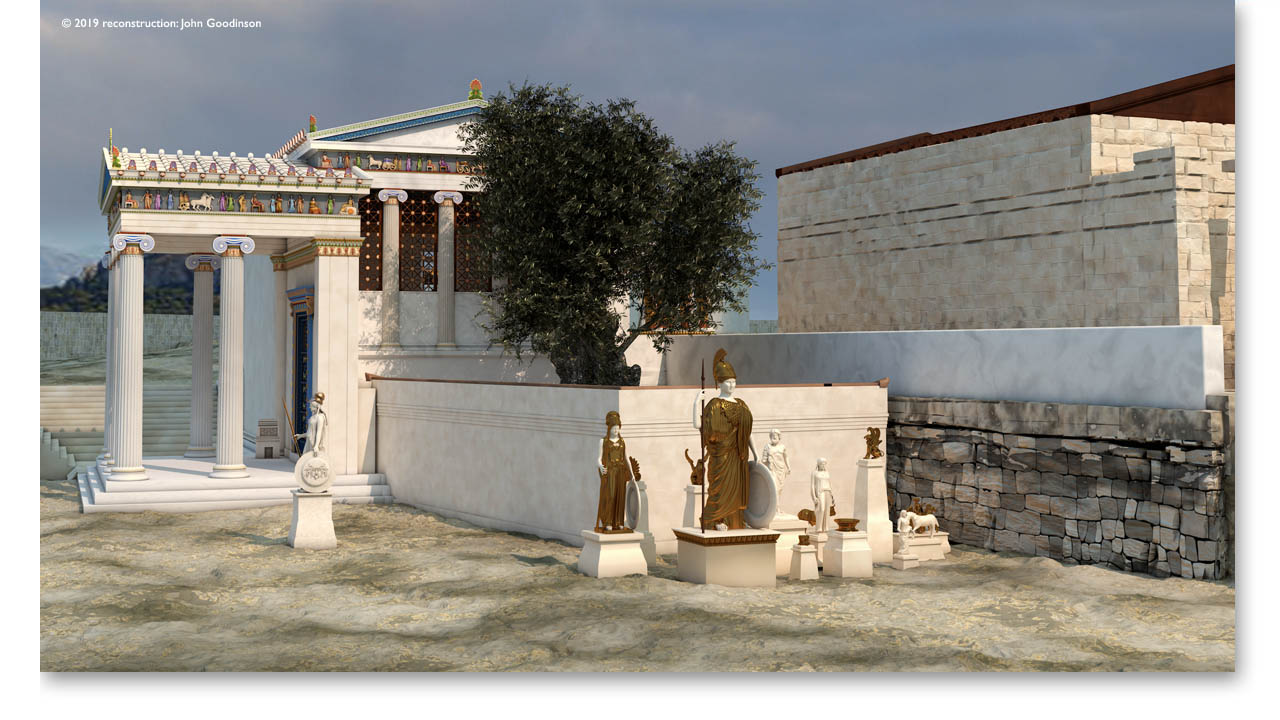Alexandra looks at a building that people think they know from its appearance in textbooks and coffee table volumes, but with a new angle. She is going to show them things about it that a quick glance just can’t tell you - the amazing feats of engineering, the odd things that happened to it, the weirdness of its construction and the most likely reasons for it.
What makes the Erechtheion so special?
For example, very few people realise that the Erechtheion was originally planned along relatively symmetrical lines like 99% of other Greek temples. Many things intervened, some of which we can prove while others are educated supposition, but the net result is an asymmetrical, transverse temple that was built over a protracted period and is known now as one of the most unusual pieces of Greek architecture in existence.
We don’t have definite proof of everything that happened, but it’s likely that there was some conflict between the priests and the architects. Perhaps the priests said, “You can’t build here,” over a sacred monument that can’t be moved - most likely the tomb of Kekrops, the Mycenaean king of Athens, over which the Erechtheion was placed. Modifications to include and not intrude on the tomb would have taken serious negotiation. There was also an ancient olive tree, sacred to the
people, that had to be accommodated.
Everything is a mishmash, and we have very good proof that changes had to be made. There is no other explanation of all the weird and wonderful things that we find in the architecture, the placement and position of the temple and the relation it had with other, even older and just as important, temples on the site.
What does Erechtheion mean?
The temple was named after Erechtheus who was one of the kings of Athens; he had a shrine inside the building. But in ancient times it would have been referred to as the Temple of Athena Polias. It was actually named in the inscription we have, very awkwardly: "the temple in which the ancient image is" - referring to the ancient olive wood image of the goddess Athena that fell from the sky in time immemorial. This is very long-winded so we abbreviate that to the Temple of Athena Polias, not to be confused with the Old Temple of Athena Polias (A.K.A. the Dörpfeld Foundations) which housed this same statue before the Persian War.
It was built over a long period, with several hiatus, probably due to shortages of money, because of what was going on socially, politically in Athens, and economically at the time. They started on a plan, they got all the blocks up to the Acropolis, started building and then, for some reason, construction stopped. Then there was a giant earthquake, for which we do have literary and physical evidence: this quake shifted some of the blocks of the already finished
Parthenon!
Finally they got going again, I like to think perhaps because they needed to appease Poseidon whose shrine within the Erechtheion complex had never been fixed after the Persian War.
Did they appease Poseidon?
Well the building hasn’t completely fallen down, at least due to another earthquake…
So we are going to be looking at the history, what people think are known facts about it and really challenging them to re-examine it. People have been looking at this building for 200 years, but nobody has really looked from its beginning to its end, to truly understand its spirit and what’s happened to it through the centuries.
The influences of the Erechtheion are phenomenal. People have been quoting it in architecture, in art, since Roman times. Even earlier in the Hellenistic period we have examples of tombs that quote the Erechtheion maidens, the emblem of the building that people are probably most familiar with.
Are those the caryatids?
Yes, although I don’t like the word caryatid when applied to the Erechtheion maidens; this term is problematic and a little bit controversial. That name was put
on them by the Romans, but it’s not accurate or correct for their original conception where they were just called korai or girls in the building inscriptions.
See MAIDENS NOT CARYATIDS for the full story.
So you will be looking at the different regimes?
We will be looking at the building as it was used and abused through time by different cultures. Different cultures came and went, the
inhabitants adjusted, it’s the history of Athens really…
But it’s a temple – did they turn it into a house?
Before they turned it into a house, the Byzantines transformed it into a church, and carved crosses all over its surface. The Franks turned it into a house during their occupation. It continued to function as such in the Ottoman period when it served the local governor and his harem of wives.
Would you equate a harem with a brothel?
No. it was very much on the model of what would have happened in Istanbul at the time, with the Sultan. Rulers were allowed to have more than one wife; it was common for any man of stature to have more than one wife and in Athens, the Erechtheion was where those wives lived.
Was it a mark of respect or a mark of degradation?
For the man it was a mark of fortune. He had to be able to prove that he could support his wives in style…
And for the building?
And for the building there are many accretions. They built little additions, as we do in our own homes today, and they filled in the spaces between the columns, making the interior spaces very private, so that no other man could look inside.
Is that part of why the spaces between the maidens on the porch are all filled in?
They were all filled in during that time; it could have just been to create another private room. We don’t know for sure.But at the time you could not see the maidens very well, a rather apt metaphor for what was going on within the building,perhaps.
Why are you involved in this project?
Another huge difference in our work is the quality of the modelling and animation….it has been an absolute privilege to have someone equally inspired by this incredibly unusual and enigmatic building working alongside me.
When we think of a Greek temple we think of something that looks like the Parthenon. 99 percent of Greek temples kind of look like the Parthenon, maybe not as grand, maybe not as rich…
But the Parthenon wasn’t a temple…
No, that’s true - the Parthenon was a treasury! It had no cult or altar of its own.
There were only a couple of temples that were called, by Vitruvius, sideways or transverse temples.
The temple of Athena Polias on the Acropolis was named by this most influential of ancient architects as one of them: Vitruvius mentions that what should be on the front, that is the door and the main colonnade, has been transferred to the sides, just as we find on the Erechtheion, and it would have been more obvious had the original, relatively symmetrical plan been followed.
A transverse temple – it sounds distinctly dodgy….
It does and it was not entirely aesthetically successful either, especially with the changes to the plan. People liked their colonnades; they liked the patterns that the light created with a long colonnade, which you don’t really get on the Erechtheion with its long blank walls. It was weird; it was wonderful.
The changes to the plan were probably due to complaints by the religious conservatives who did not want to move the
shrines around in order to accommodate the new fandangled ideas of the architect.
What relationship did it have to the old temple of Athena?
The old temple of Athena was destroyed and burned down by the Persians during the Persian wars of the early 5th century BC. Much of that temple remained standing as a monument, a memorial, to this devastation that the Greeks still feel deeply
today.
The Erechtheion was built just to the north of the old temple of Athena, as a replacement. But the maiden porch
overlaps and actually bites its teeth into the foundations of the old temple of Athena. That was done very deliberately
as a symbol of the connection between the old temple and her new home in the Erechtheion.
The view from the south west that we love today and that appears on most postcards - where you can see the west façade and the maiden porch and a bit of the north porch - were impossible in ancient times. The carcass of the Archaic temple, a burnt out husk of the central building, was used as a treasury throughout Classical times, Hellenistic times, maybe even into Roman times as well, and would have blocked the view that we always think of as the Erechtheion…
So the maidens were looking directly at the old temple?
They were looking directly at the cella of the old temple where the ancient statue, essentially just a plank of olive wood, had stood; and the maidens stood there with their phialai in perpetual libation to her former home as if saying, “Persians, we shall never forget what destruction you wrought on our city and her goddess.”
By the way, phialai are the libation bowls still used in the Catholic church – they are bowls with a belly button in the middle that you would use to pour out a wine or a blood sacrifice from the oxen, there were hundreds of oxen that would have been sacrificed – smelly, bloody, really rather gruesome…
During the Panathenaic festival we know that a hundred perfect oxen were slaughtered. They did a Greater Panathenaia every 4 years, kind of like the Olympic Games, and then each year they would put on a smaller festival.

Where was Athena in all of this?
Athena's image was represented by a piece of olive wood that had apparently fallen from heaven and had been housed in the old temple of Athena south of the Erechtheion before the Persian destruction.
During the Panathenaic festival, she was presented with a set of robes woven by her acolytes, the arrephoroi. Later on, she was probably carved to be more anthropomorphic, and decorated with jewellery and various other accoutrements.
But she was literally just a plank of olive wood; that was her form. She didn’t really look like a goddess the way we think of Athena now. There were plenty of statues on the Acropolis that depicted Athena in various guises, as goddess of war, as goddess of wisdom, as the leader of the Athenian people in democracy, but in the Erechtheion the most ancient, most sacred statue of her was just a plank of wood as far as we understand.
Lesk on Athena
Contacts
John Goodinson Artist/designer/illustrator
Christina Jansen Photographer
Phenomenists Internet Agency/ISP
The British Museum London England
The Acropolis Museum Athens Greece
Maxon Software Developer
Our affiliate partner
Theran Press is the academic publishing imprint of Silver Goat Media. Theran is dedicated to authentic partnerships with its academic associates, to the high quality design of scholarly books, and to elite standards of peer review. Theran seeks to liberate intellectuals from the confines of traditional academic publishing. Theran authors are authorities and revolutionaries in their respective fields.
Theran encourages new models for generating and distributing art, science, and knowledge. For our creatives. For our communities. For our world.
Our Hosting Partner
Phenomenists Internet (ISP) was founded in 2000, to meet a growing demand for cost-effective and
reactive internet services, Phenomenists have provided the hosting services and support for all our online projects since 2008. John Goodinson is a member of the creative team and has worked with Phenomenists since 2008.
